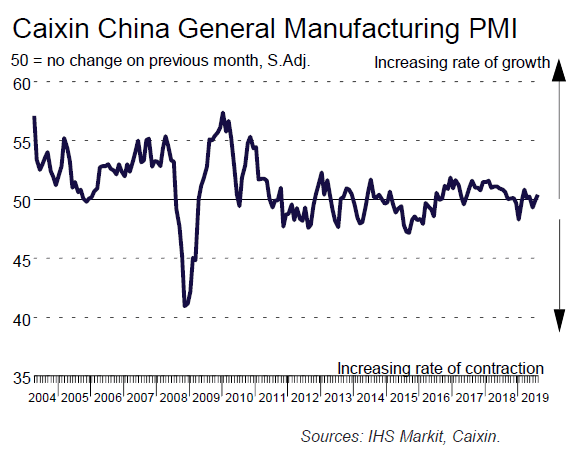China Caixin PMI Manufacturing rose to 50.4 in August, up from 49.9 and beat expectation of 49.8. Caixin note marginal expansion of output. New orders were broadly stable despite further decline in export sales. However, output charges fell at quickest rate since December 2015.
Commenting on the China General Manufacturing PMI™ data, Dr. Zhengsheng Zhong, Director of Macroeconomic Analysis at CEBM Group said:
“The Caixin China General Manufacturing PMI stood at 50.4 in August, up from 49.9 in the previous month, showing an improvement in the manufacturing sector.
“The subindex for new orders stayed in expansionary territory, but it inched down, suggesting flat demand for manufactured products. The gauge for new export orders remained in contractionary territory and fell to the lowest level this year in August, reflecting declining foreign demand amid an intensifying trade dispute between China and the U.S. The output subindex stayed in positive territory and rose further, pointing to increased production activity.
“The employment subindex jumped to a level only marginally lower than the 50-point mark that divides expansion from contraction, showing a relative improvement in labor market conditions.
“The subindex for stocks of purchased items fell further into negative territory, reflecting manufacturers’ growing reluctance to replenish inventories. The subindex for suppliers’ delivery times dropped further into decline, indicating that they have delayed deliveries even longer. The measure for stocks of finished goods rebounded into positive territory, suggesting growing inventories amid the improved production environment. However, it remains to be seen whether production will continue to improve.
“Although it remained in positive territory, the gauge for future output dropped, reflecting subdued confidence among manufacturers. We don’t expect they will soon become more willing to invest. Both the measures for input costs and output charges dropped, implying that industrial prices were on a downward trend.
“China’s manufacturing sector showed a recovery in August, mainly due to improved production activity. However, overall demand didn’t improve, and foreign demand declined notably, leading product inventories to grow. There was no sign of an improvement in companies’ willingness to replenish inventories of inputs or in their confidence. Industrial prices trended down. China’s economy showed signs of a short-term recovery, but downward pressure remains a long-term problem. Amid unstable Sino-American relations, China needs to step up countercyclical policies.”













